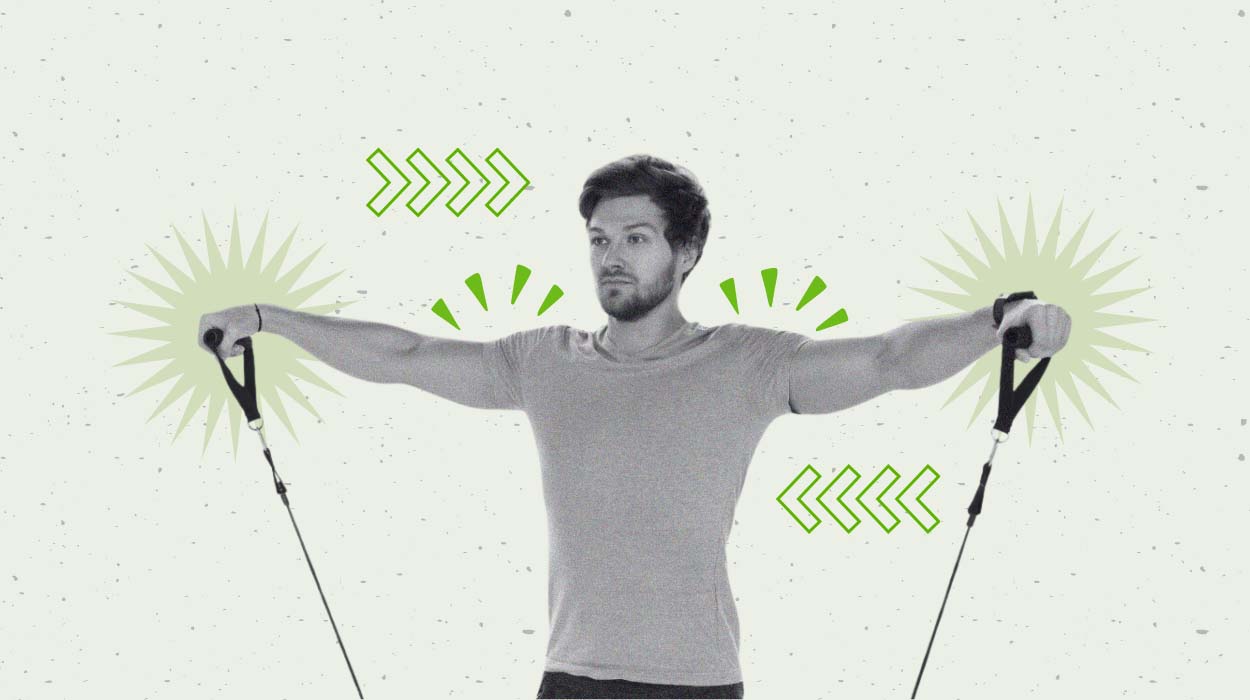
Shoulder training with resistance bands isn’t just about switching up your routine — it’s a whole new ballgame. Sure, weights and the latest gym gadgets are always discussed but don’t underestimate the power of a good resistance band. It’s your go-to for a great workout that’s as flexible [1] as you need it to be.
You’re laying down the foundation for a solid, all-around shoulder workout by kicking things off with rear delt exercises. With shoulder band exercises, you’ll explore movements that refine muscular endurance and fortify the shoulders [2] against injury. Each exercise contributes uniquely to your body’s symphony of movement.
Embrace this guide as a companion in your quest for peak physical prowess. The practices you’ll adopt are more than just motions; they’re stepping stones to a stronger, more agile you.
Best Resistance Band Shoulder Exercises In 2024
The top resistance band exercises for effective shoulder training:
- Standing Lateral Raise: Engages medial deltoids, enhances shoulder definition, and improves posture.
- Standing Reverse Fly: Strengthens posterior deltoids and upper back, aiding in posture correction and reducing injury risk.
- Standing Front Raise: Targets anterior deltoids, which are crucial for lifting movements, and supports overall shoulder functionality.
3 Best Shoulder Band Exercises In 2024
Shoulder band exercises are the perfect companion for any part of your fitness journey. Below, you’ll find a handpicked selection of the best moves to elevate your workout routine to its peak potential.
Standing Lateral Raise With Resistance Bands
Lateral raises with resistance bands really shine when boosting shoulder strength and carving out those deltoids. With every lift, the band keeps the pressure steady, something dumbbells just can’t match. This means your muscles are working overtime, from start to finish.
This constant tension stimulates the shoulder muscles more effectively, improving muscle tone and endurance.Performing this exercise can contribute significantly to better posture and shoulder health. It targets the often-neglected medial deltoid,[3] which is essential for lateral arm movements and can aid in balancing muscular development around the shoulder joint. Moreover, resistance bands are adaptable to various fitness levels, allowing for progression as your strength increases.
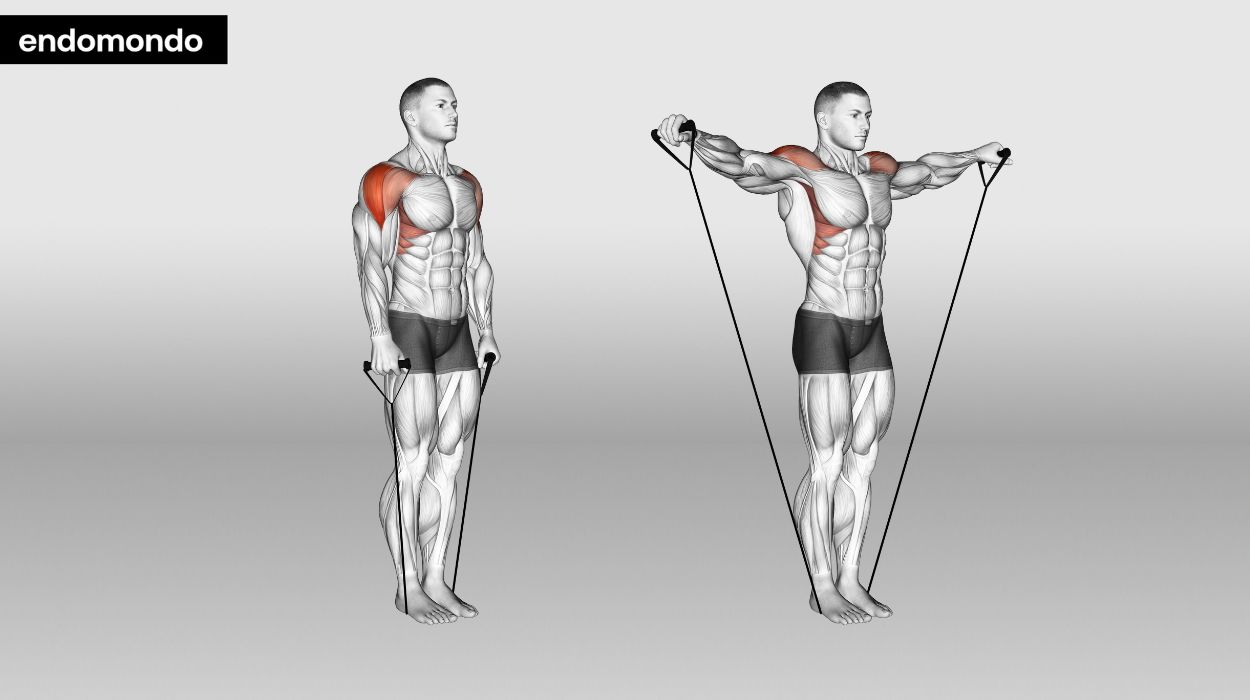
How to do:
- Stand in the middle of the band with feet shoulder-width apart.
- Grasp the ends of the band with palms facing inwards.
- Keep your arms straight and lift them to the side, up to shoulder level.
- Pause at the top, then lower back down with control.
Tips:
- Keep your core engaged throughout the movement to stabilize your torso.
- Avoid using momentum; the resistance band should provide sufficient tension.
Optimal Sets & Reps: 3 sets of 10-12 repetitions.
Standing Reverse Fly With Resistance Bands
The reverse fly with resistance bands does wonders for more than just your back. It’s a key player in building functional strength and bolstering shoulder stability. This works not just your rear delts [3] but also engages your entire upper back, hitting the rhomboids and trapezius muscles hard.
The reverse fly helps pull back the shoulders to where they should be, helping improve upright posture and lower the chance of shoulder injuries. This makes it perfect for those who spend hours hunched over a desk or behind the wheel. The smooth resistance offered by bands is also kinder to your joints than traditional weights. This makes it a welcoming option for all fitness levels.
Slide the reverse fly into your workout mix, and you’ll find it complements other moves like lateral head tricep exercises beautifully, ensuring your upper body strength is as complete as it is robust.
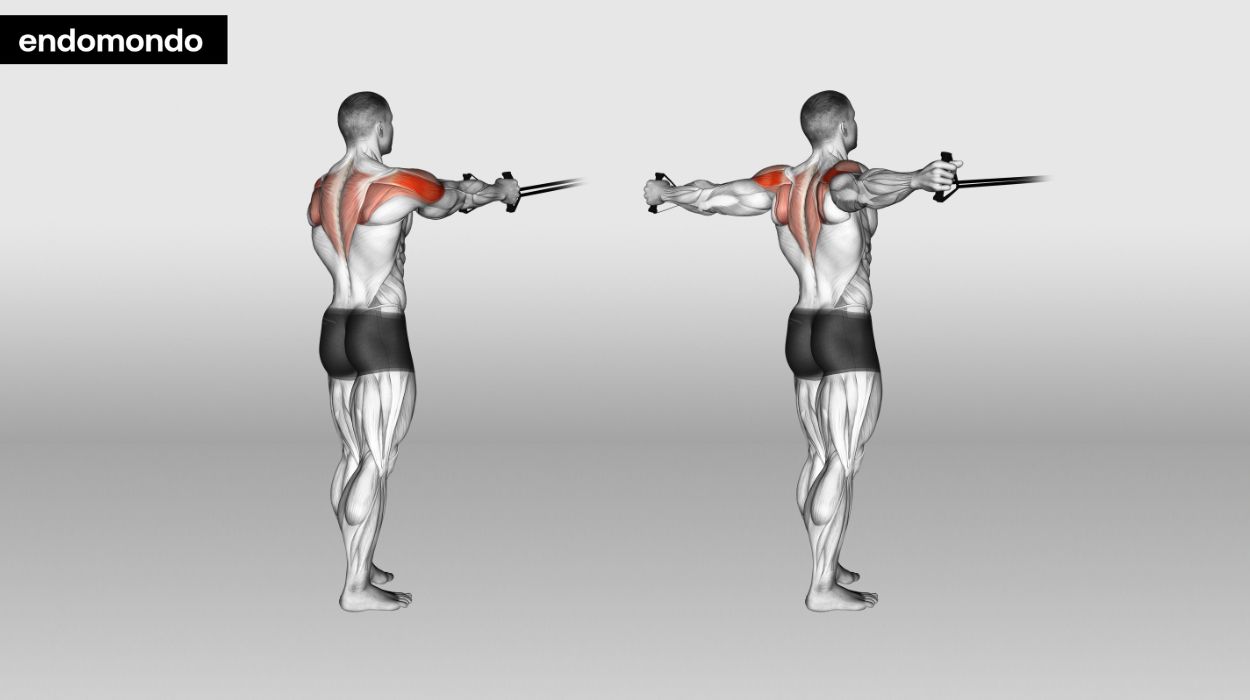
How to do:
- Begin by standing with your feet shoulder-width apart, placing the center of the band underneath both feet.
- Bend forward slightly at the hips to a 45-degree angle, keeping your back straight and head aligned with your spine.
- Grasp each end of the band with your hands in front of you, keeping your elbows slightly bent.
- With a braced core, exhale as you extend your arms out to the sides, squeezing the shoulder blades together.
- Hold the contraction at the top for a moment, then slowly return your hands to the starting position as you inhale.
Tips:
- Keep the movement slow and controlled to maximize the engagement of the posterior deltoids and upper back.
- Avoid using momentum to lift the arms; let your muscles do the work.
- Adjust the band tension by stepping wider for more resistance or narrower for less.
Optimal Sets & Reps: 3 sets of 12-15 repetitions.
Standing Front Raise With Resistance Bands
Front raises are fantastic for zeroing in on your anterior deltoids. These muscles kick into gear every time you lift your arms in front. But it’s not just about looking good — although that’s a definite bonus. This shoulder exercise is key for maintaining strong, functional shoulders, vital for everyday tasks and more complex movements.
As you perform the front raise, the resistance band provides a progressive challenge [4] that free weights cannot offer. It maintains tension on the deltoids even at the peak of the movement.
This tension is key in stimulating muscle growth and strength. Additionally, front raises help to stabilize the rotator cuff muscles, which are crucial for injury prevention and shoulder integrity. Combining this with other effective movements, including cable shoulder workouts and lat pull-down alternatives, ensures a comprehensive training program.
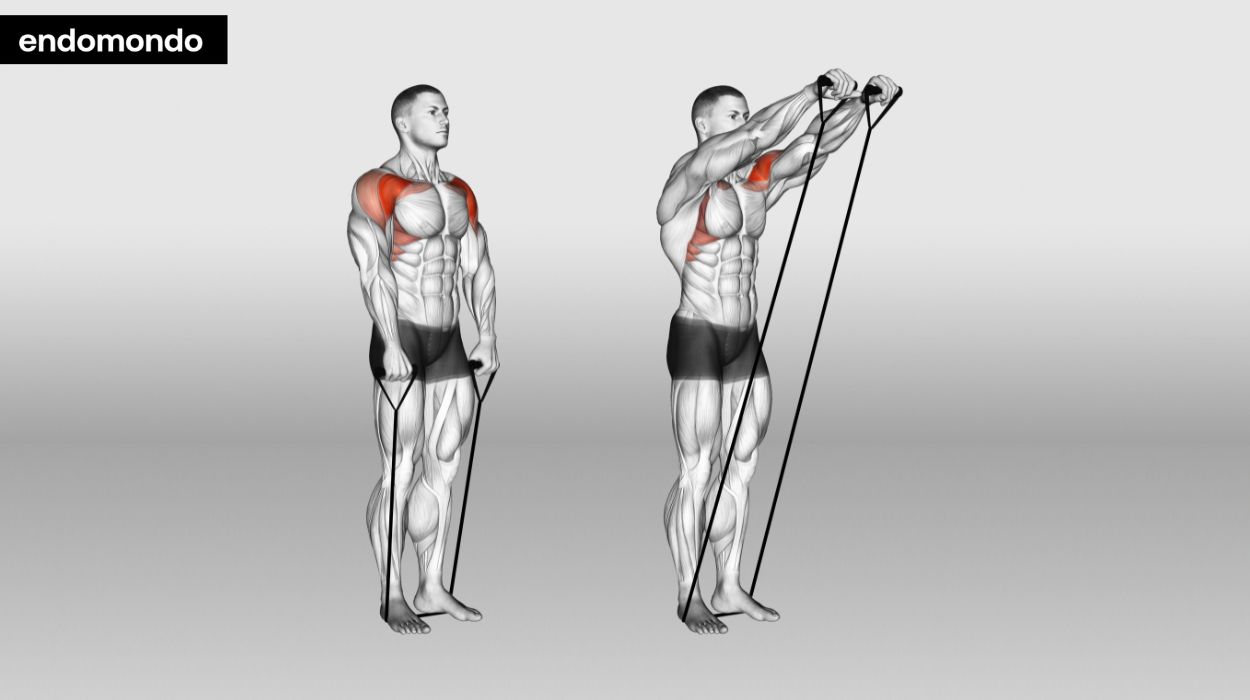
How to do:
- Stand with feet shoulder-width apart, the center of the band under your feet.
- Grip the ends of the band with your palms facing down.
- Keeping your arms straight, raise them in front of you to shoulder height.
- Hold the position briefly, then slowly lower the hands back to the starting position.
Tips:
- Ensure you move your arms upward with your muscles rather than momentum.
- If the tension is too low, shorten the band by stepping wider or gripping it further from the ends.
Optimal Sets & Reps: 3 sets of 12-15 repetitions.
Health Benefits Of Shoulder Band Exercises
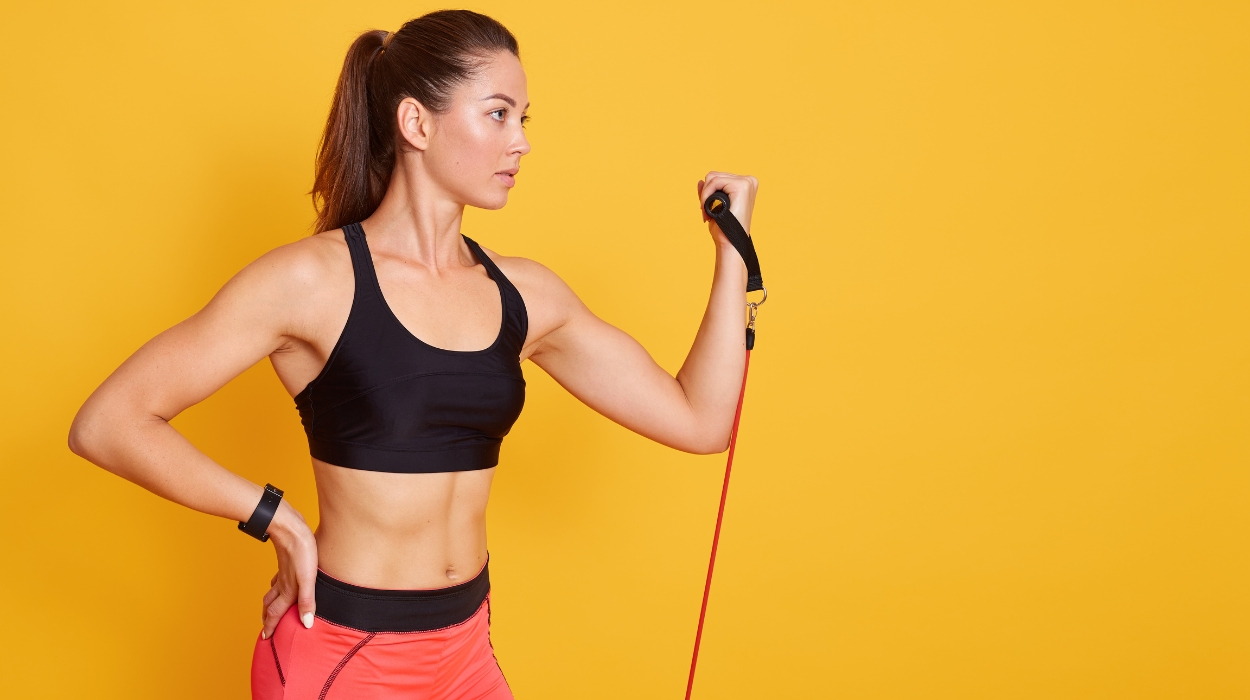
By integrating these exercises into your routine, you’re not simply working out — you’re investing in your well-being. Let’s take a closer look at how these exercises can be a game-changer for your physical health:
- Enhanced Joint Stability: Resistance bands provide a unique resistance that can help to fortify the muscles around your shoulder joints, leading to improved stability and a lower risk of injury.[5]
- Increased Muscle Endurance: Regularly practicing shoulder workouts with resistance bands can increase muscular endurance. This means you’re better equipped for daily tasks and other forms of physical activity.
- Improved Postural Support: Strengthening the muscles surrounding the shoulder blades, such as those engaged during band shoulder exercises, contributes to better posture [6] and alleviates back discomfort.
- Versatile Muscle Activation: Whether you’re performing lateral raises or exploring front delt workouts, resistance bands allow for a full range of motion,[7] engaging multiple muscle groups simultaneously.
Considerations For A Good Resistance Band

Selecting the right resistance band is like choosing the perfect partner for your workout journey — it needs to match your goals and comfort level. Here are some key considerations to keep in mind to ensure you find a good resistance band:
- Material Quality: Look for bands made from durable, high-grade latex or non-latex materials, especially if you have latex sensitivities. This ensures longevity and consistent resistance.
- Resistance Level: Bands come in various resistance levels, typically indicated by color. Start with a lighter resistance if you’re new to shoulder resistance band exercises, and progress to higher resistance as you build strength.
- Length and Width: The band’s dimensions will affect the range of exercises you can perform. Longer bands are versatile for a full-body workout, while shorter bands can be more targeted.
- Comfort and Grip: Ensure the band doesn’t pinch or pull your skin uncomfortably. Some bands come with handles or loops for better grip and ease of use.
- Portability: One of the benefits of resistance bands is their portability. Consider how easy it is to pack and carry the band, particularly if you travel often or like to work outdoors.
You’re set for various exercises when you’ve got the right resistance band in your gym bag. This includes everything from shoulder band exercises to enhancing your front delt workouts and even integrating them into your best barbell triceps workout routine. The right band will help you perform each exercise effectively, safely, and with maximum benefit.
Wrapping Up
Effectively incorporating shoulder band workouts into your fitness routine is beneficial. It builds strength similar to long-head biceps exercises.
The simplicity and efficacy of resistance bands provide a path to improved strength, stability, and range of motion in the shoulder region. As you continue to apply these exercises combined with others like short head bicep exercises, the benefits will manifest not just in your workouts but in daily life. With every stretch of the band, you’re paving the way for a more capable, dynamic self.
Frequently Asked Questions
Lateral raises and reverse flyes top the list for their effectiveness in targeting the deltoid muscles comprehensively.
Absolutely; exercises like band pull-aparts and external rotations are stellar for fortifying the rotator cuff muscles. What are the best resistance band shoulder exercises?
Yes, with the proper exercises and under professional guidance, resistance bands can aid in shoulder rehabilitation.
Resources
- Lopes, J.S.S., Machado, A.F., Micheletti, J.K., de Almeida, A.C., Cavina, A.P. and Pastre, C.M. (2019). Effects of Training with Elastic Resistance versus Conventional Resistance on Muscular strength: a Systematic Review and meta-analysis. SAGE Open Medicine, [online] 7, p.205031211983111. doi:https://doi.org/10.1177/2050312119831116.
- Schedler, S., Brueckner, D., Hagen, M. and Muehlbauer, T. (2020). Effects of a Traditional versus an Alternative Strengthening Exercise Program on Shoulder Pain, Function and Physical Performance in Individuals with Subacromial Shoulder Pain: A Randomized Controlled Trial. Sports, 8(4), p.48. doi:https://doi.org/10.3390/sports8040048.
- Campos, Y.A.C., Vianna, J.M., Guimarães, M.P., Oliveira, J.L.D., Hernández-Mosqueira, C., da Silva, S.F. and Marchetti, P.H. (2020). Different Shoulder Exercises Affect the Activation of Deltoid Portions in Resistance-Trained Individuals. Journal of Human Kinetics, 75(1), pp.5–14. doi:https://doi.org/10.2478/hukin-2020-0033.
- Fang, Q., Zhang, X., Xia, Y. and Huang, F. (2023). Integrating elastic band into physical education classes to enhance strength training. 14. doi:https://doi.org/10.3389/fpsyg.2023.1037736.
- Liaghat, B., Pedersen, J.R., Husted, R.S., Pedersen, L.L., Thorborg, K. and Juhl, C.B. (2022). Diagnosis, prevention and treatment of common shoulder injuries in sport: grading the evidence – a statement paper commissioned by the Danish Society of Sports Physical Therapy (DSSF). British Journal of Sports Medicine, 57(7), p.bjsports-2022-105674. doi:https://doi.org/10.1136/bjsports-2022-105674.
- Lee, D.Y., Nam, C.W., Sung, Y.B., Kim, K. and Lee, H.Y. (2017). Changes in rounded shoulder posture and forward head posture according to exercise methods. Journal of Physical Therapy Science, [online] 29(10), pp.1824–1827. doi:https://doi.org/10.1589/jpts.29.1824.
- Choi, H.-M., Hurr, C. and Kim, S. (2020). Effects of Elastic Band Exercise on Functional Fitness and Blood Pressure Response in the Healthy Elderly. International Journal of Environmental Research and Public Health, 17(19), p.7144. doi:https://doi.org/10.3390/ijerph17197144.




